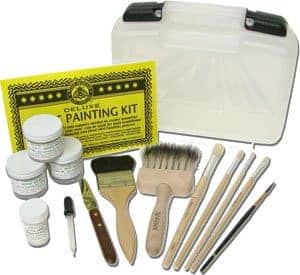Coloured Paints And Enamels
Coloured stained glass paint is a fantastic way of getting exciting designs permanently onto float (window) glass. It means that you can do very large, free designs that don’t cost a fortune.
Sometimes called low firing enamels, these paints are fired at between 1022F/550C and 1040F/560C.

This is a commission for a house boat that used no other technique except several layers of paint, fired repeatedly in a kiln.
These three photos show the development from the first to the last paint firing.
You can see how colour and texture build throughout the process.
You will need to do colour tests of all the stages and keep a log of your kiln firing schedule, so that you will be able to repeat the process at a later date.
Which side shall I paint on?

To get bright and consistent colours when using enamels on float glass, you must paint on a particular surface. It’s called the ‘air side’.
This only applies to the combination of coloured enamels and window glass. The enamels change colour if painted on the ‘tin’ side. So how do you know which surface is the tin side?
Using a UV flashlight
You can determine this by using a short wave UV flashlight. This sometimes called a Tin Side Detector.
By looking at your sheetglass in a darkened room with the UV flashlight under and up against the glass, you will see the tinned surface showing up as a blurry white ring. You won’t see this ring on the air side.
Using a single drop of water!
– Clean the window sheetglass
– Hold it at about a 45 degree angle, and drop one drop of water on to one side
– Turn over and repeat
– Compare the flow of the drop
– The water drop will break up and become uneven on the tinned surface
– Use the other (air) side for painting enamels on to.
What shall I apply the stained glass paint with?

This art work uses a combination of sponges and badger brushes for the painting.
The sponges for the textured, more definite ‘lines’, the badger brush for the blended background.
The secret, and the reason for so many firings, is to put lots of thin layers of paint and to gradually build up the colour.
This enables you a high degree of control over the finished window – you don’t want the stained glass paint too wishy washy, nor do you want it to bubble up and be too dark to see through.
Pros and cons of coloured paint
Against
– Coloured stained glass paint doesn’t have the transparency and vibrancy of artglass. It isn’t glass and can never replicate it.
– The low firing enamels aren’t weatherproof.
– You need access to a kiln for firing the paint.
For
– You can paint very large areas with a near-infinite amount of colours.
– You don’t have to break up your design with lead lines, which can make for a very light, free window.
– You can control the depth of color and subtlety of you work with the stained glass paint.
– You can add all sorts of painted textures and patterns.
This painting starter kit is available on Amazon Peter Mcgrain Deluxe Paint Starter Kit (paid link)


